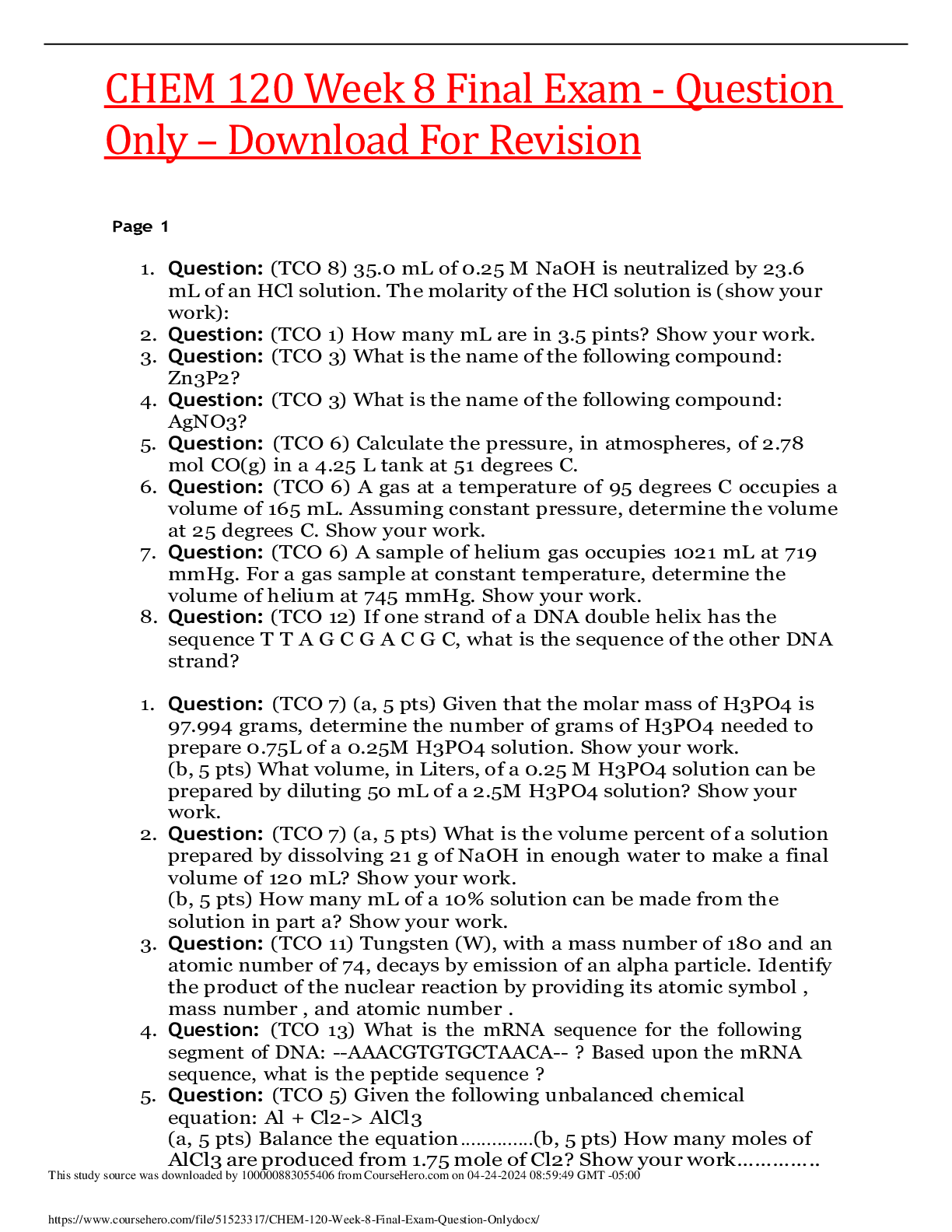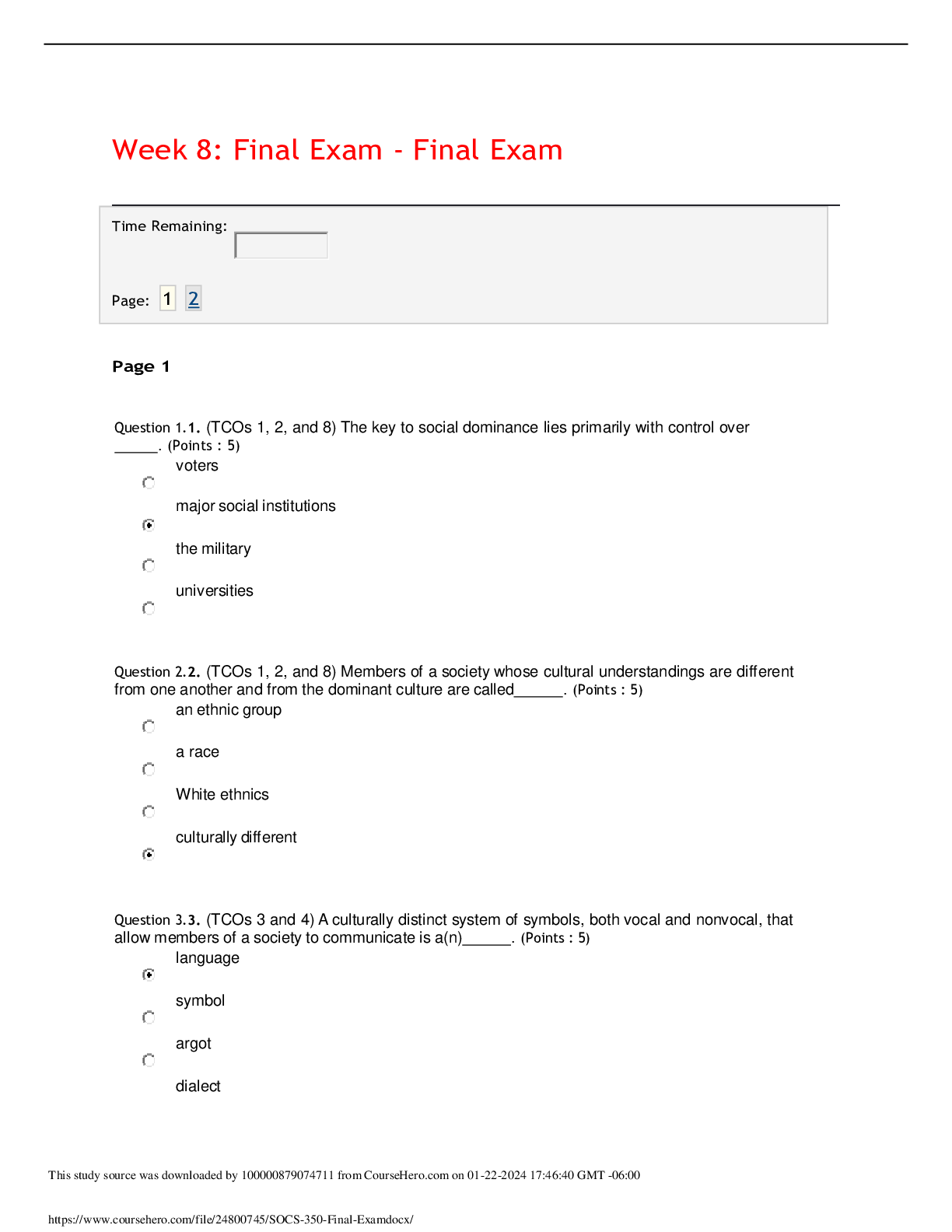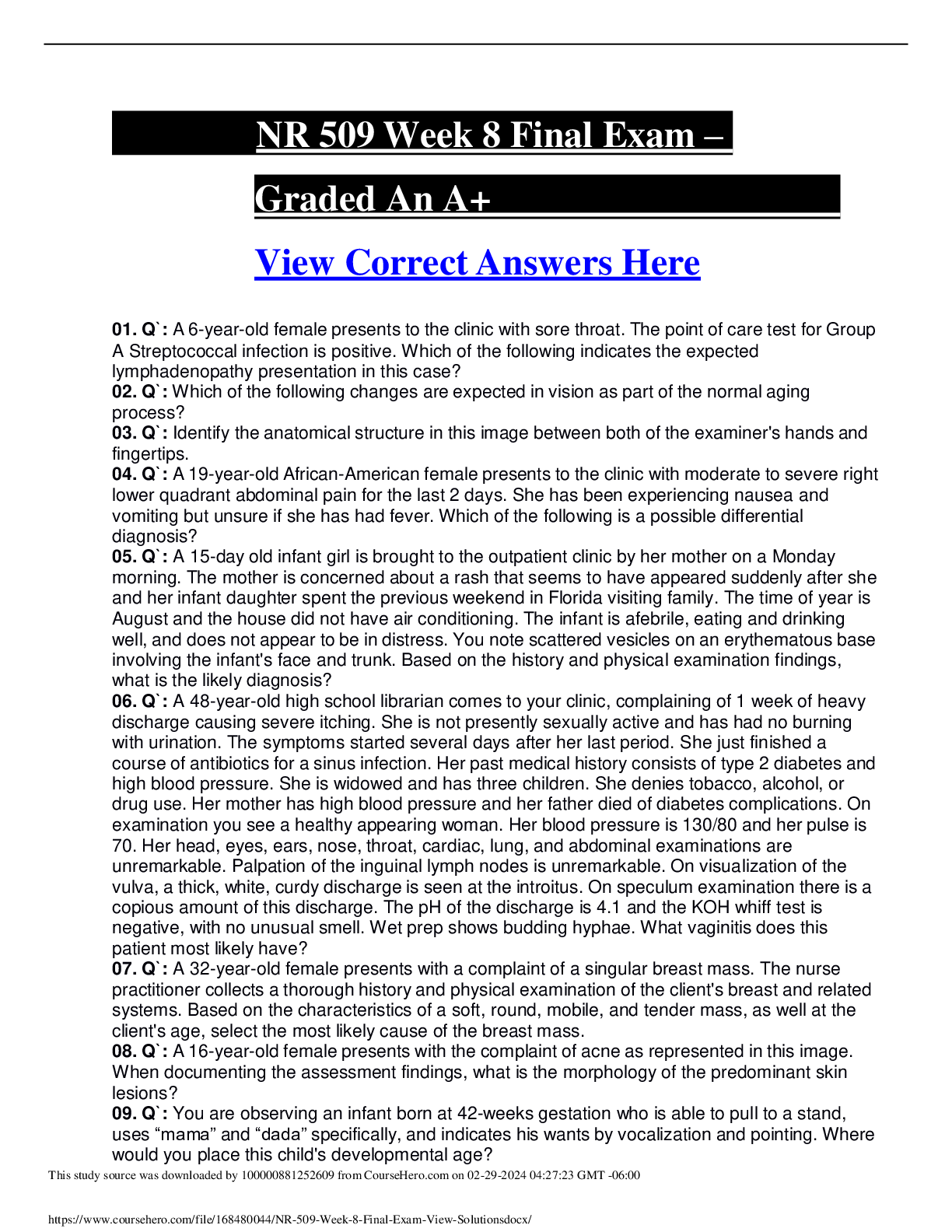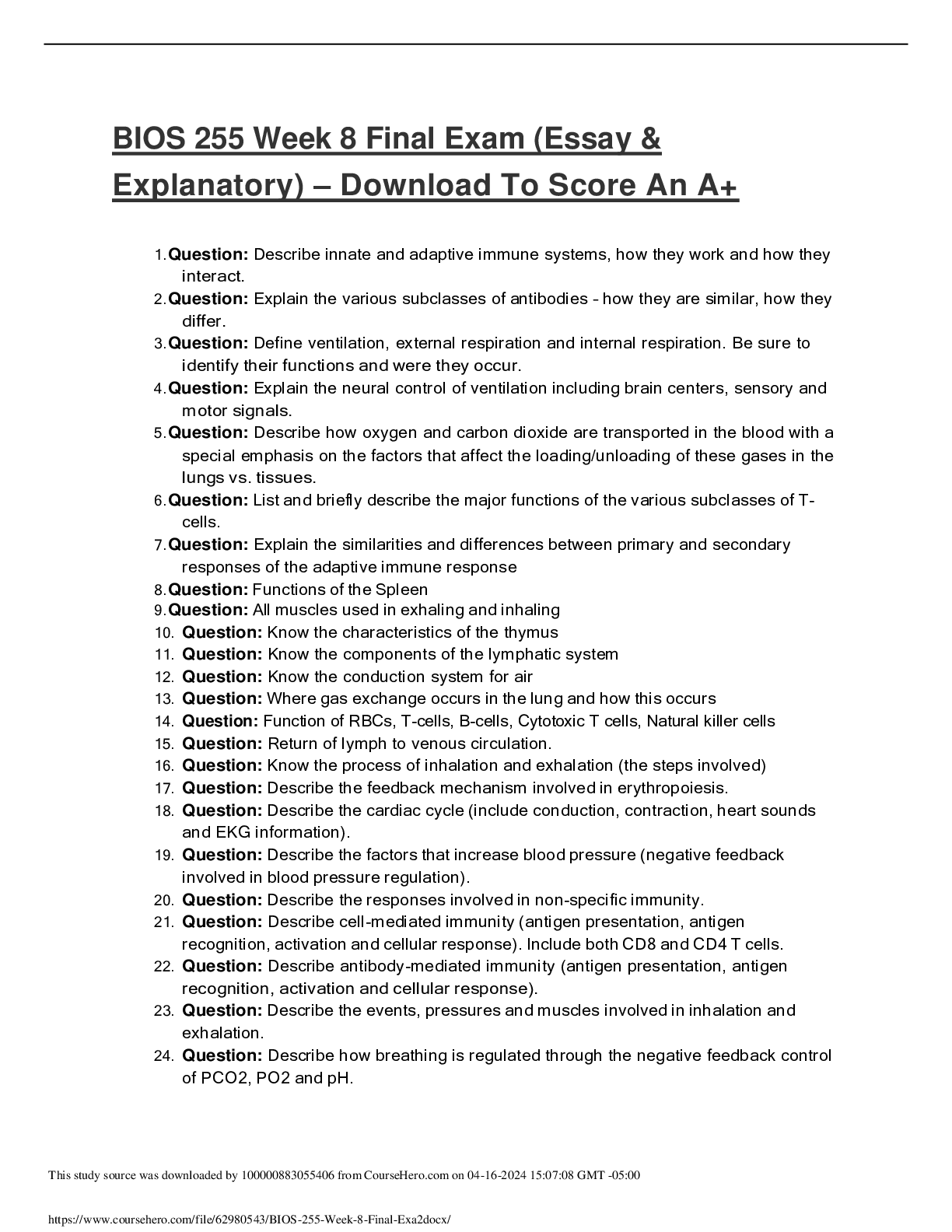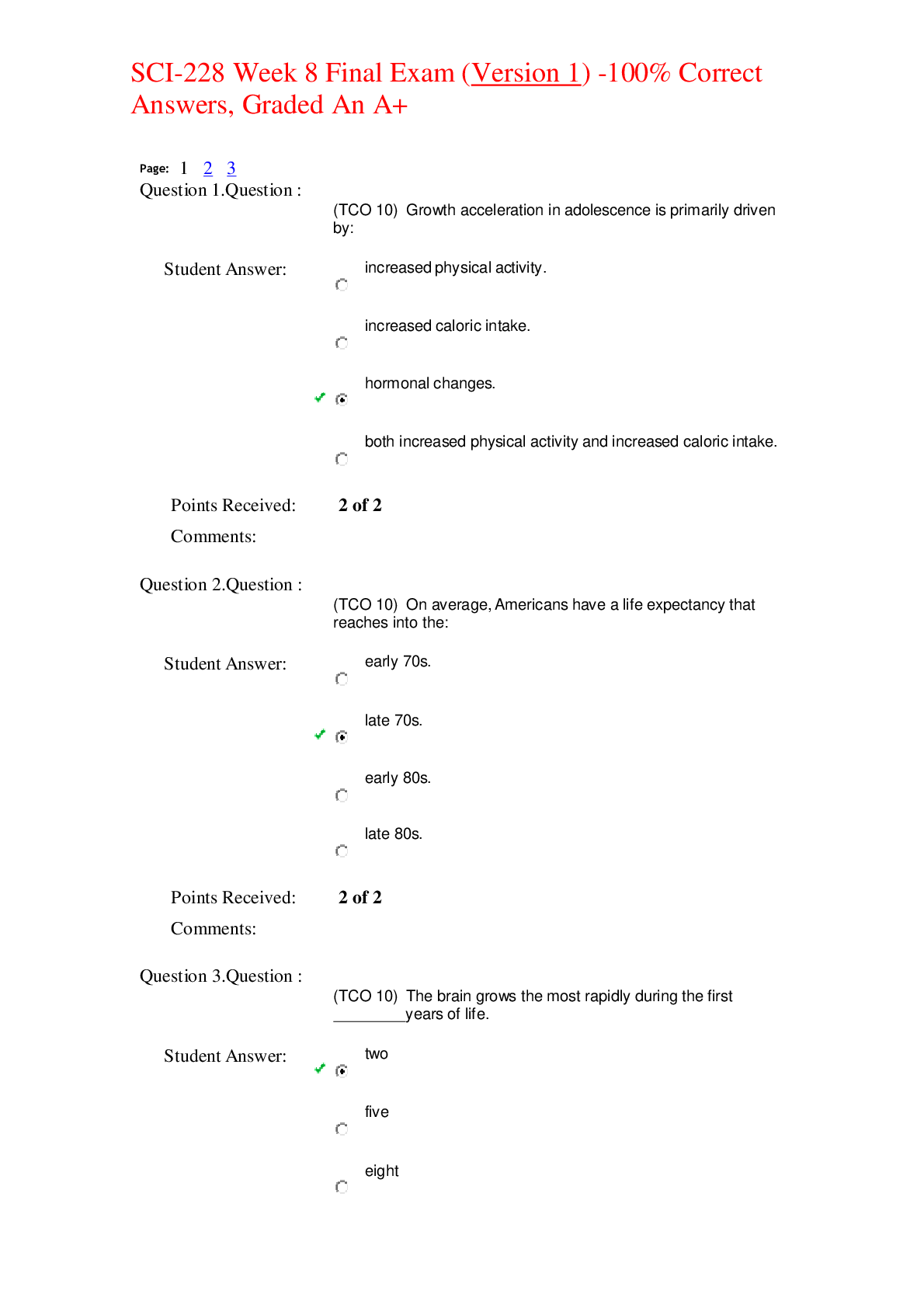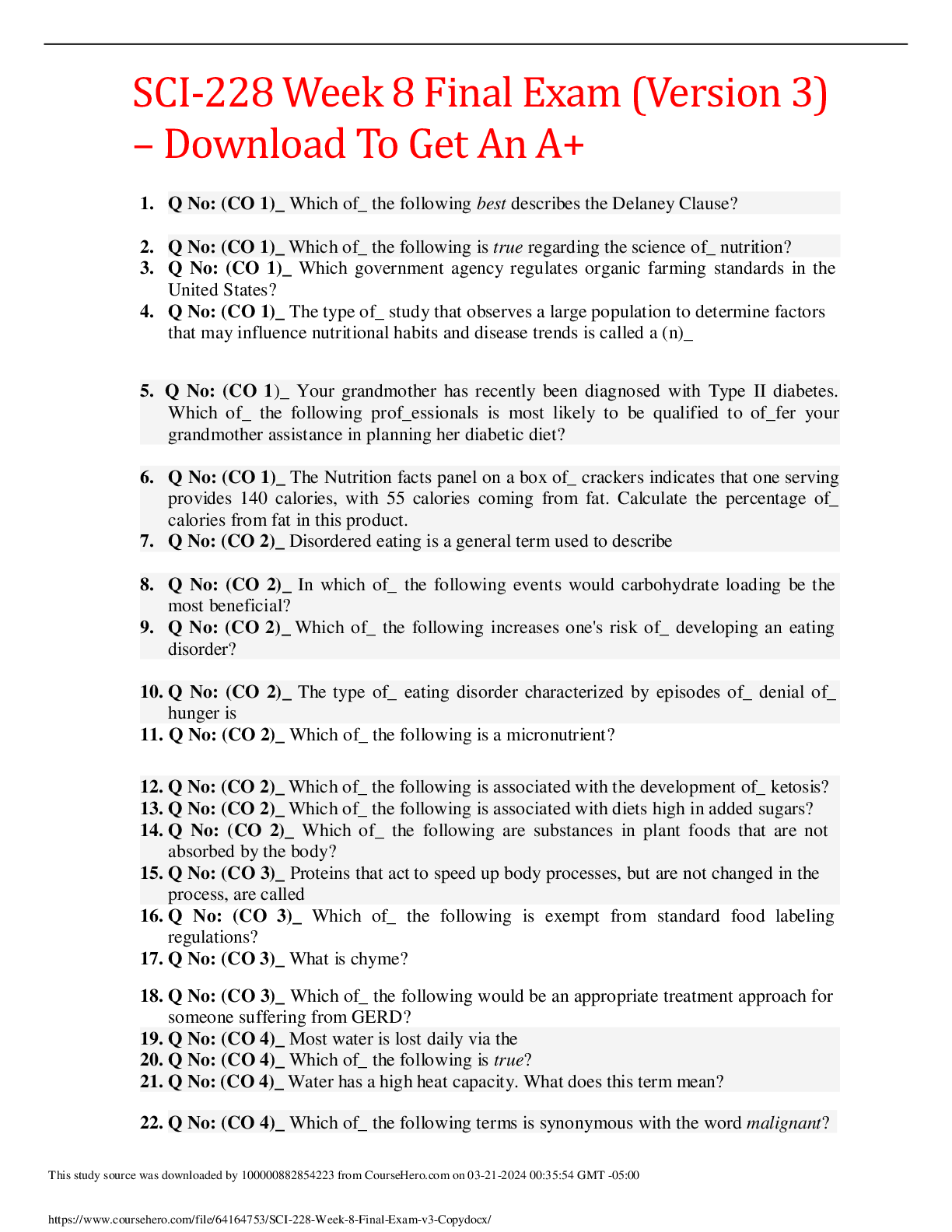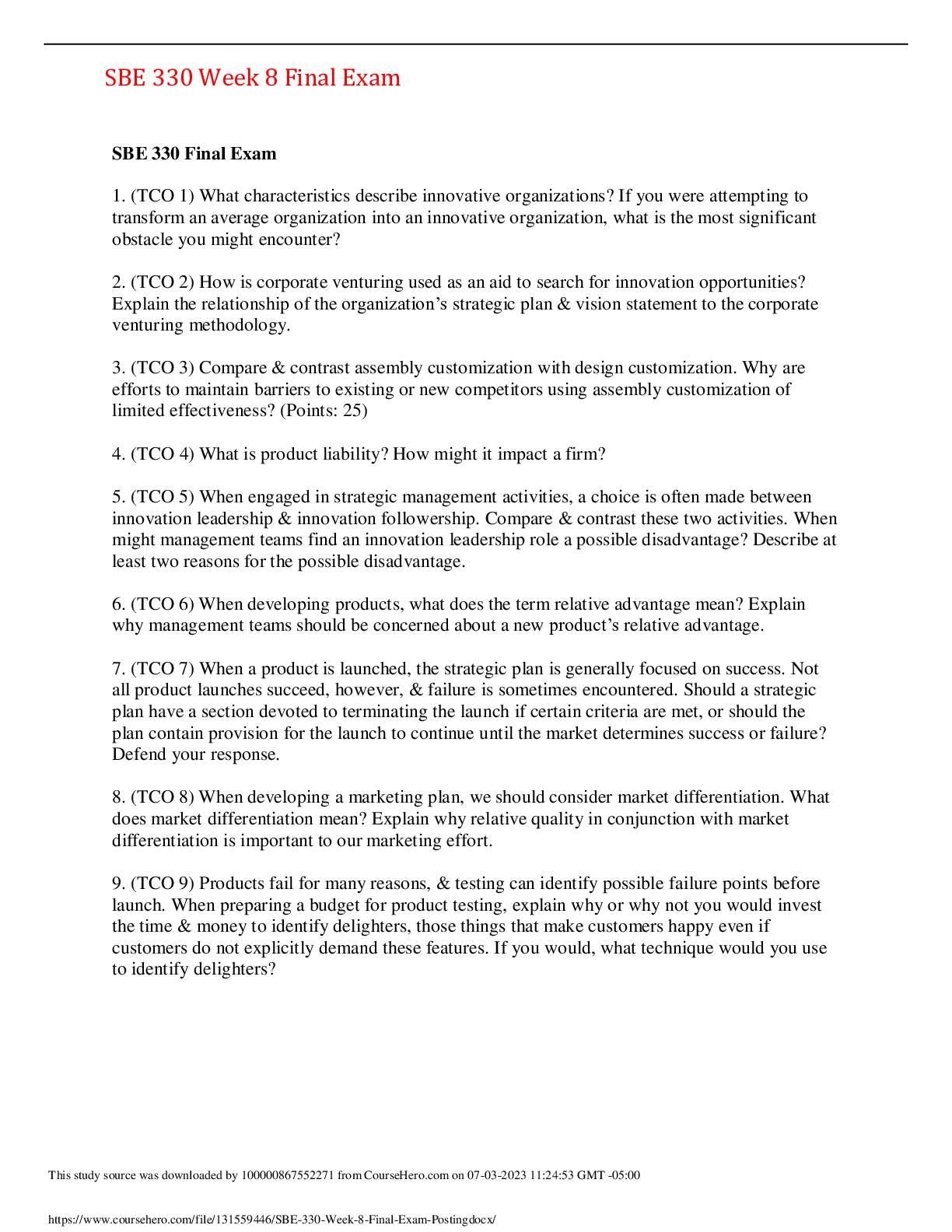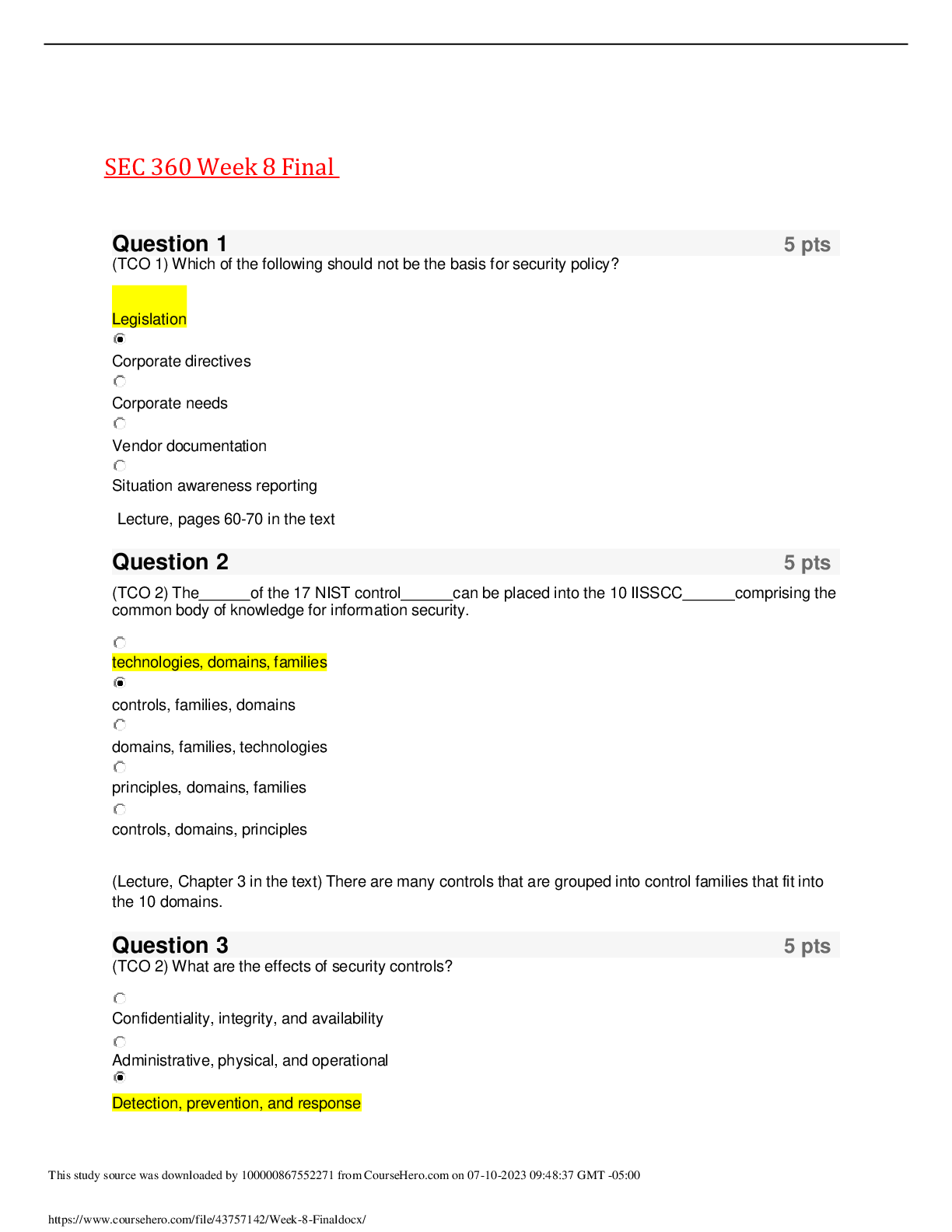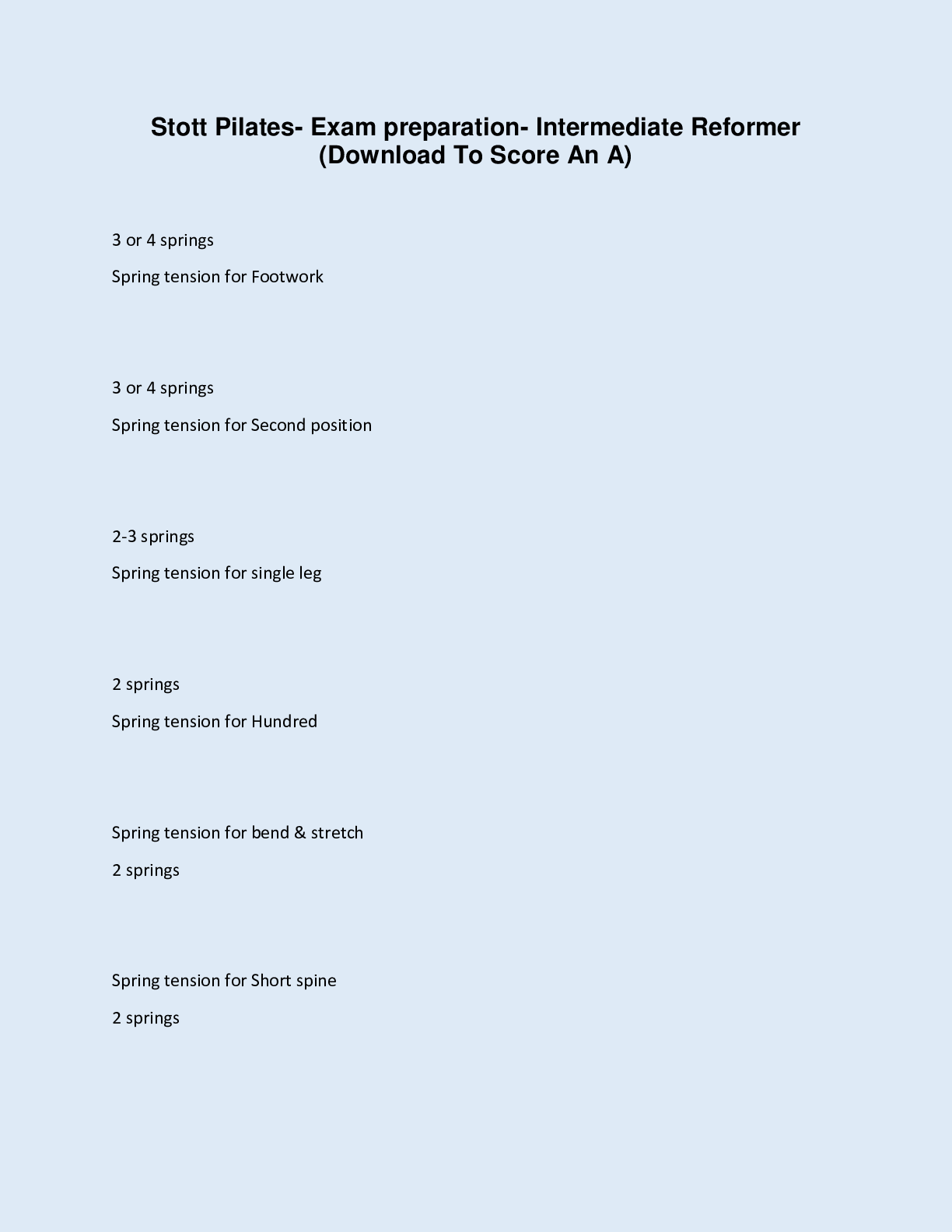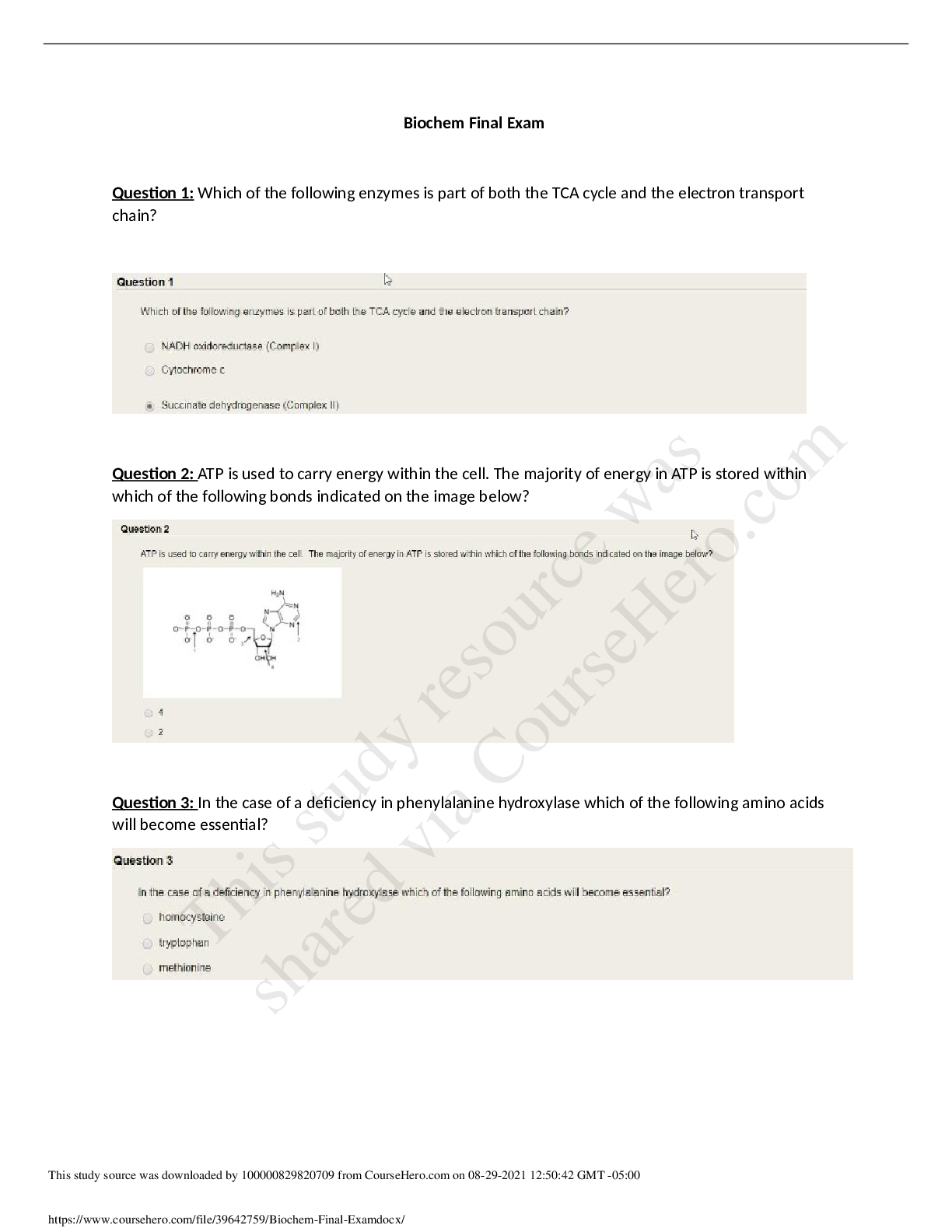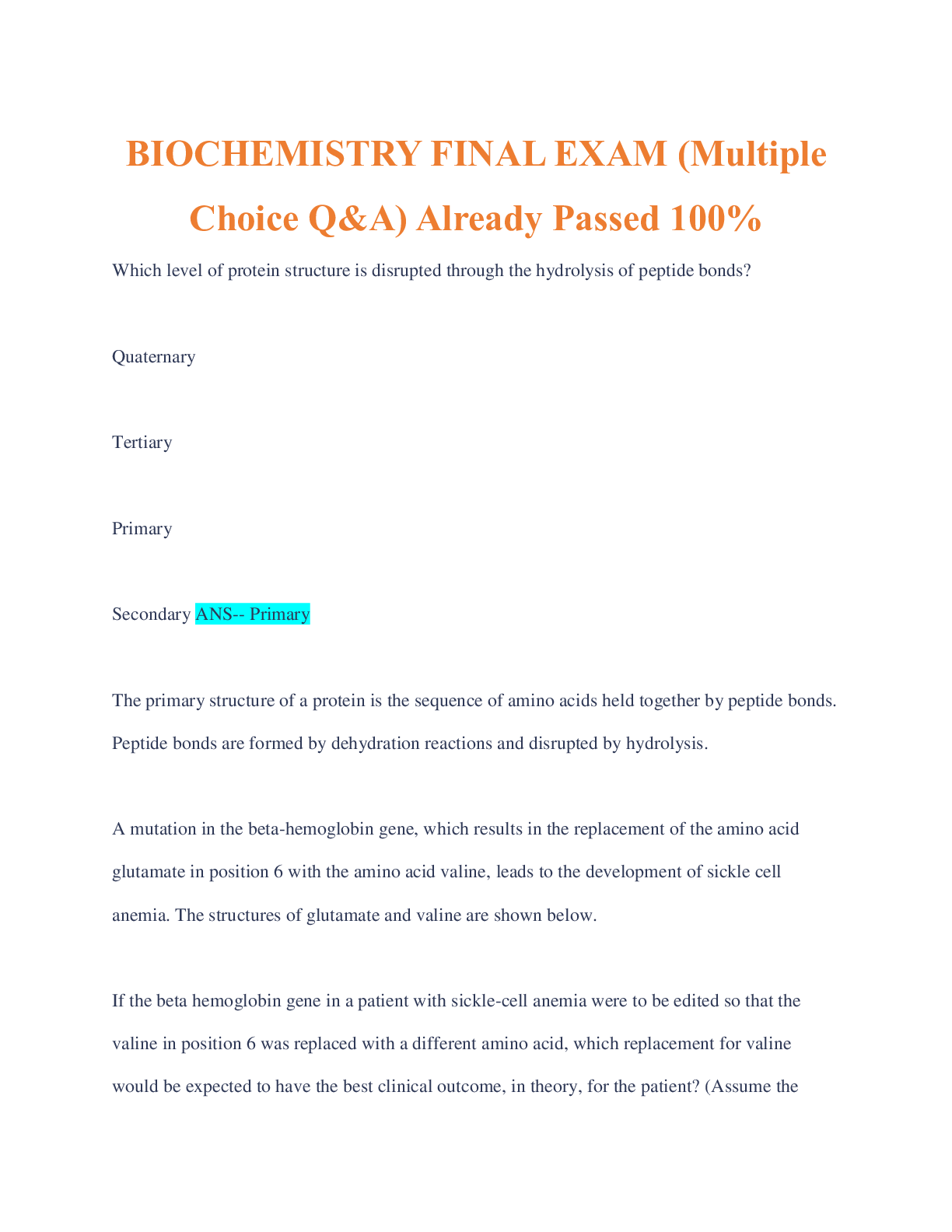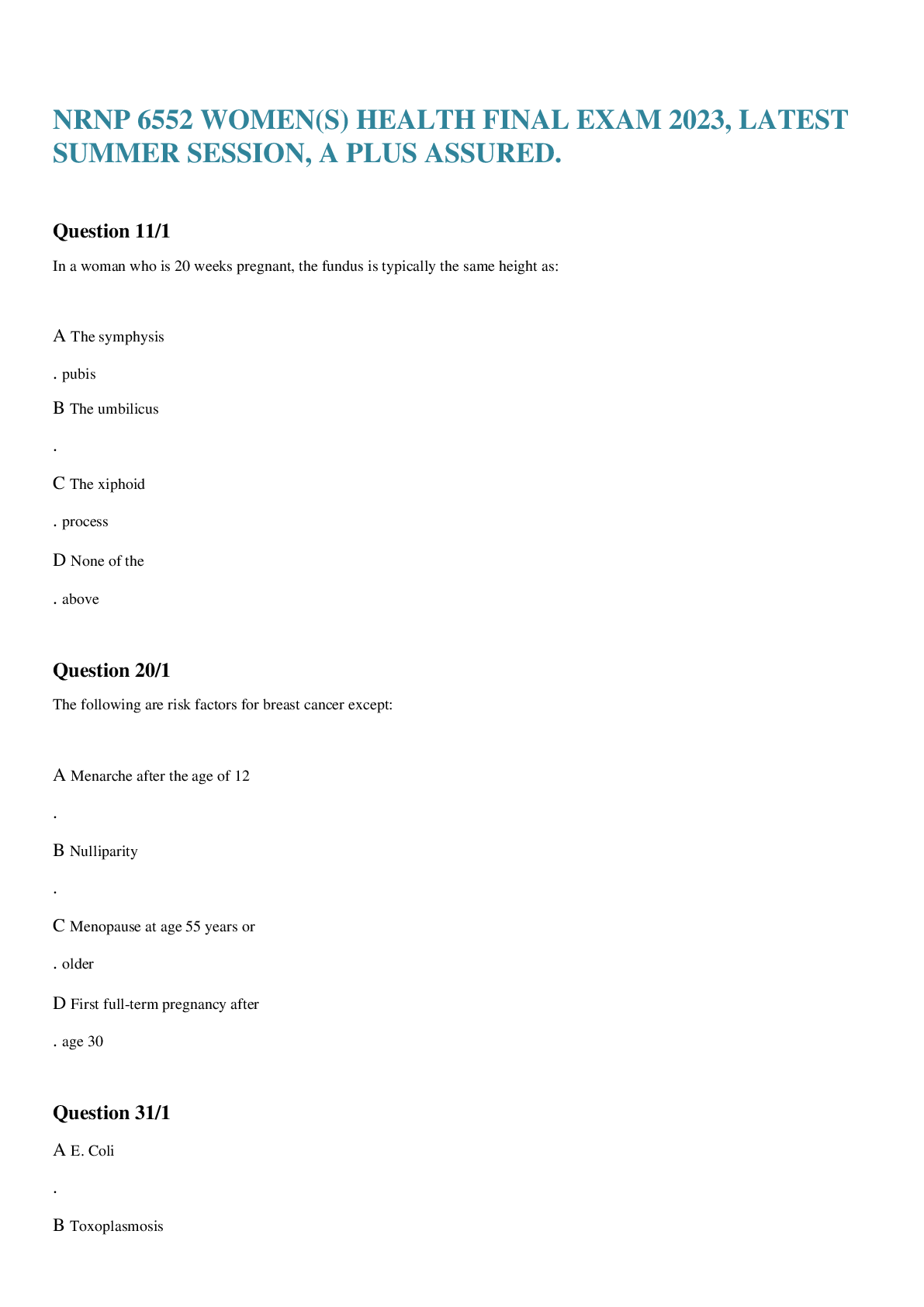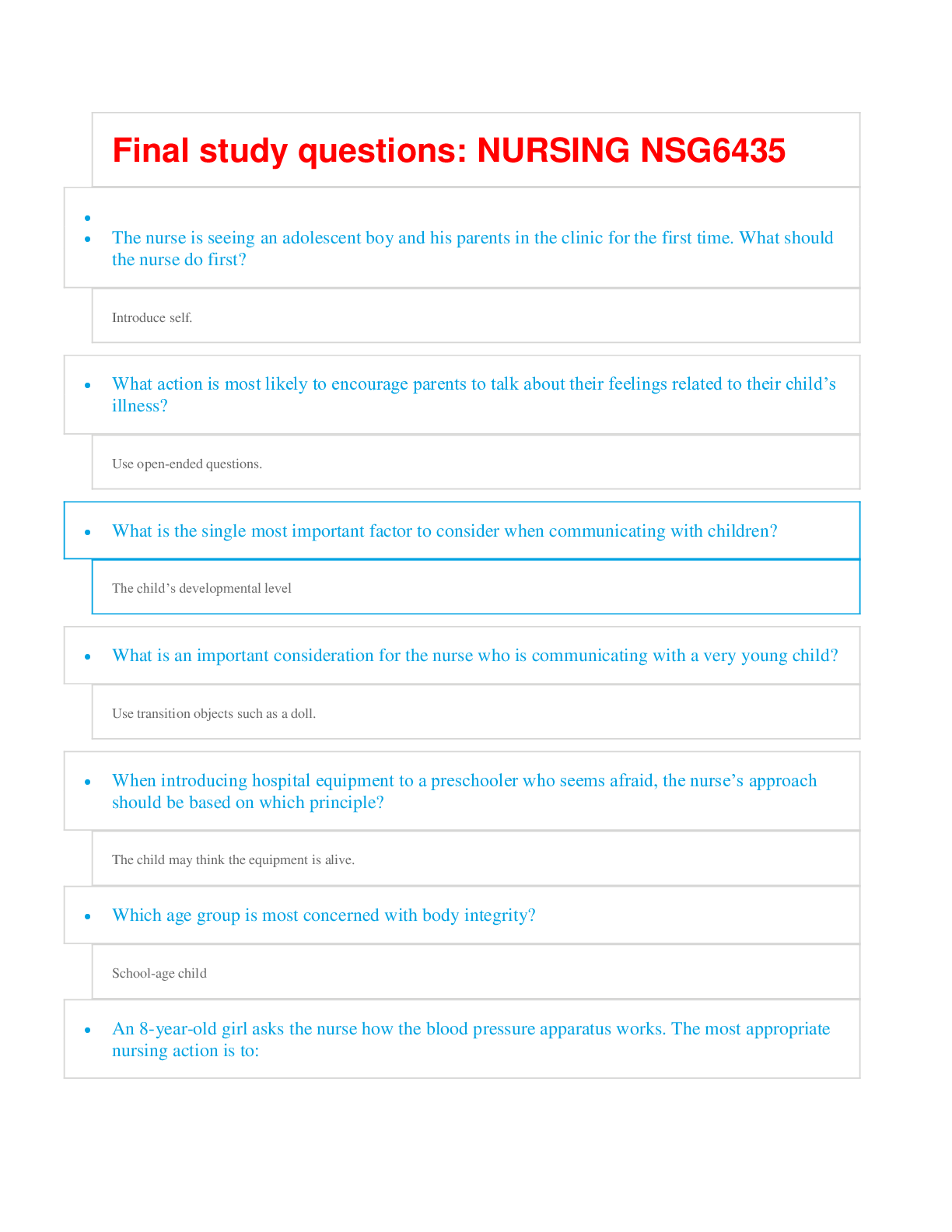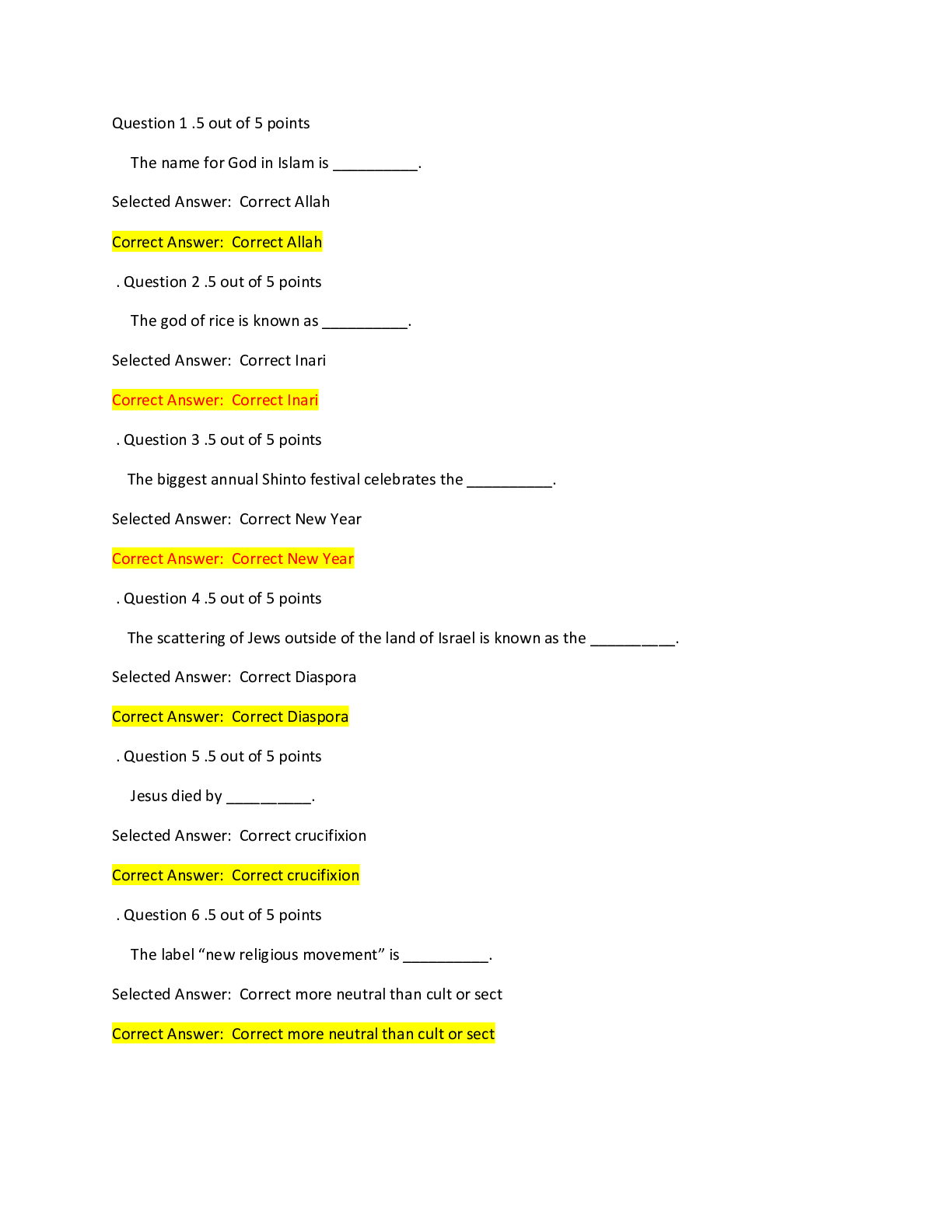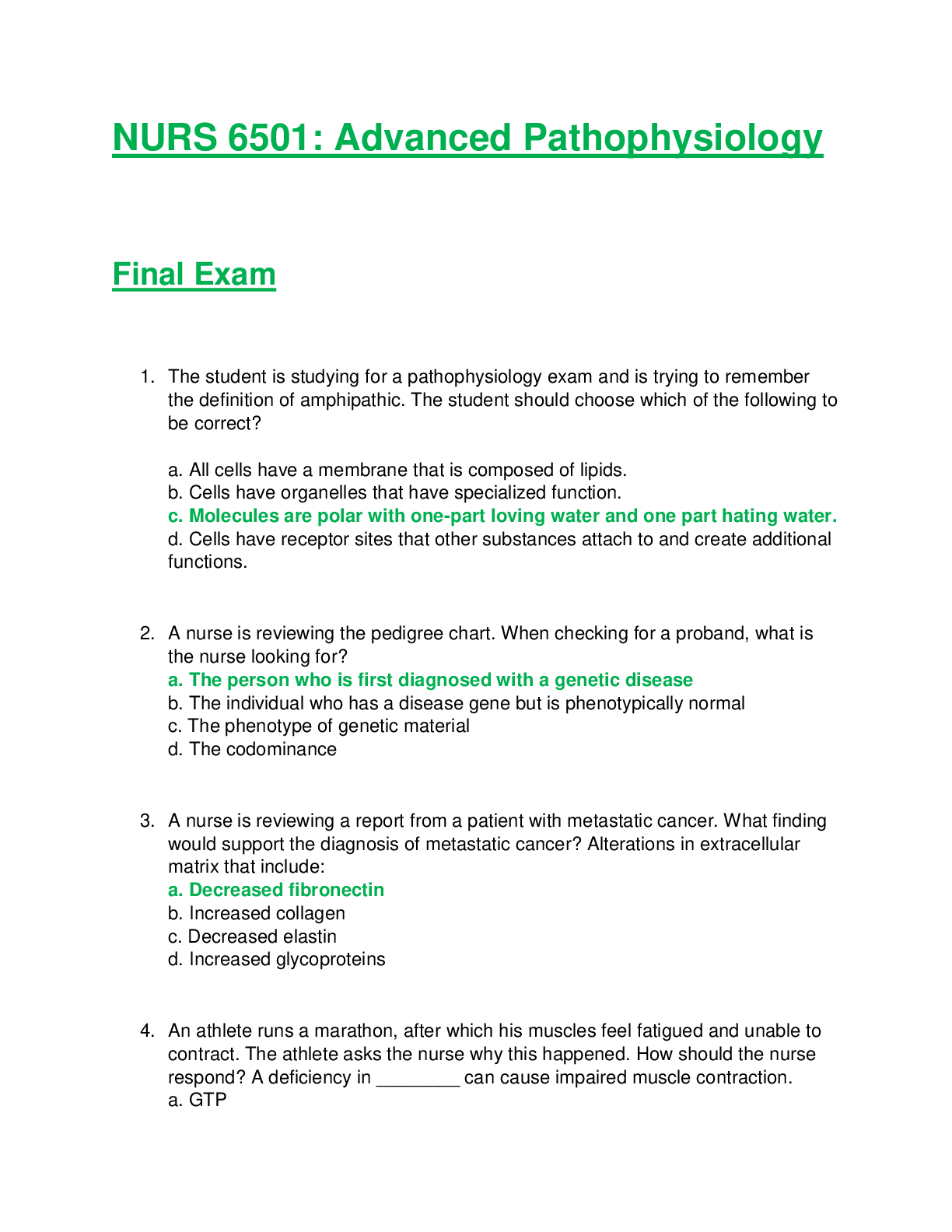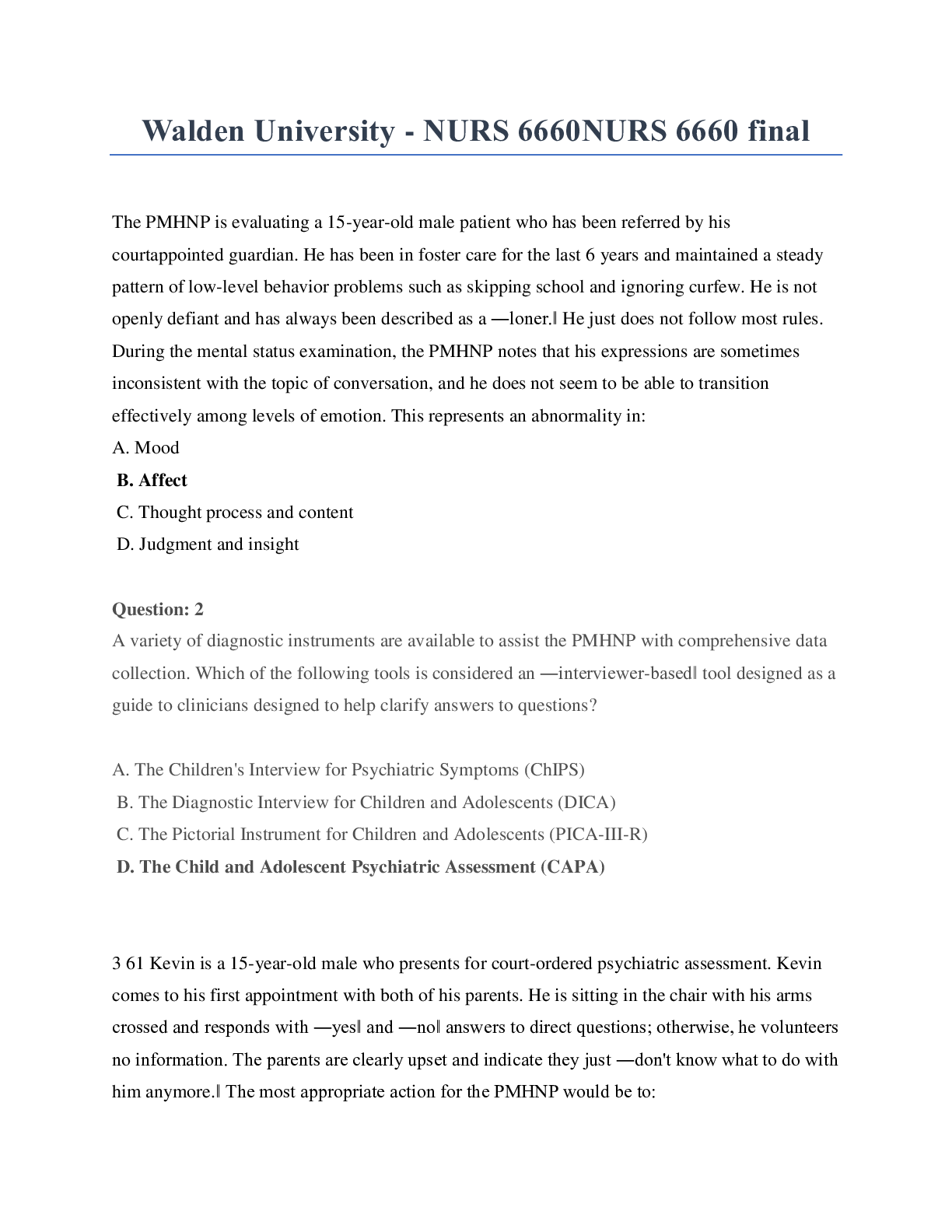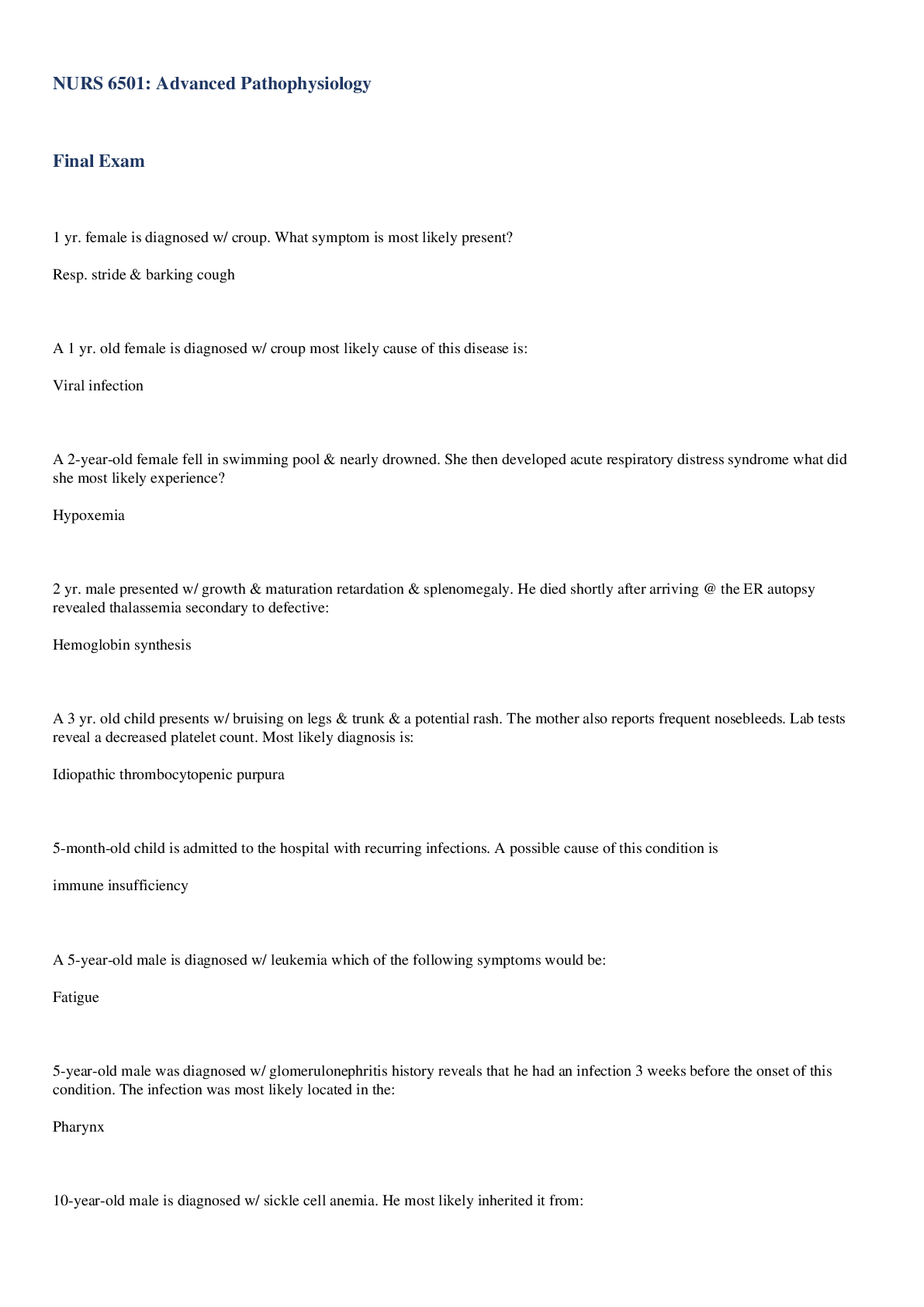Accounting > FINAL EXAM > ACCT 212 Week 8 Final Exam – Download To Score An A+ (All)
ACCT 212 Week 8 Final Exam – Download To Score An A+
Document Content and Description Below
1. (TCO 3) At the end of the period it is necessary to close all temporary accounts. (1) Explain why this process is required (10 points) and (2) provide an example of the (10 points) (Points : 20) 2... . (TCO 2) As required to complete Course Project 1, one must follow the cycle that includes 10 steps to complete the accounting cycle. (1) Explain how the debit/credit rules are used….. (10 points)(Points : 20) 3. (TCO 5) Internal Control Procedures are required to safeguard company assets and to ensure ethical operation of the business. (1) Explain how limited access can satisfy the…... (10 points) (Points : 20) 4. (TCO 4) Inventory valuation methods determine the cost of goods sold and the inventory balance. (1) Explain how the First in First out (FIFO) method is applied (10 points) and (10 points) (Points : 20) 5. (TCO 1) To evaluate the financial operation and health of a business ratio analysis is used. (1) Provide the formula for the Current Ratio and explain how it is computed (10 points) and (2) provide an example of how this ratio can be used in decision-making in business. (10 points) (Points : 20) 6. (TCO 6) BagODonuts Company bought a used delivery truck on January 1, 2010, for $19,200. The van was expected to remain in service 4 years (30,000 miles). BagODonuts’ accountant estimated that the truck’s residual value would be $2,400 at the end of its useful life (Points : 25) 7. (TCO 7) ABC Inc. was incorporated on 1/15/12. Their corporate charter authorized the following capital stock: Preferred Stock: 7%, par value $100 per share, 100,000 shares. Common… (Points : 25) 8. (TCO 5) Fraud is an intentional misrepresentation of facts, made for the purpose of persuading another party to act in a way that causes injury or damage to that party. In our readings and discussions we have seen several examples of fraud in business. Using that …... 9. (TCO 5) Internal Control Procedures are in place to protect the assets of every business as mentioned in the textbook and our discussions. Of the seven internal control procedures, list five of these controls and describe how each procedure is implemented (Points : 25) 10. (TCO2) Below are the accounts of Super Pool Service, Inc. The accounts have normal balances on June 30, 2012. The accounts are listed in no particular order…. (Points : 25) 11. (TCO4) Linda’s Lampshades started business on Jan. 1, 2001. They had the following inventory transactions:……(Points : 25) 1. (TCO 3) At the end of the period it is necessary to close all temporary accounts. (1) Explain why this process is required (10 points) and (2) provide an example of the closing of an expense account, Salary Expense in the form of a journal entry. (10 points) (Points : 20) 1. We have to close temporary accounts at the end of a period because when the temporary accounts are closed, it brings their balances back down to zero. 2. I would Debit Salary Expense and Credit to Payroll Expenses 12/31 DR Salary Expense 1000 Cr Payroll 1000 2. (TCO 2) As required to complete Course Project 1, one must follow the cycle that includes 10 steps to complete the accounting cycle. (1) Explain how the debit/credit rules are used when developing journal entries (10 points) and (2) provide an example of the application of the debit/credit rules in the form of a journal entry. (10 points)(Points : 20) 1. In accounting, a debit increases the balance and a credit decreases the balance. The accounts that have a normal debit balance are assets, the owner's equity, expenses and losses. Normal credit balances are liabilities, equity, revenue, and gains. When we debit an account, we raise the balance. When we credit the account, we decrease the balance. Using a double entry system, we would debit one account and credit the other to get the journal in balance. 2. An example would be debit rent expense and credit bank account. DR Rent Expense 3000 CR Checking 3000 To record rent expense for the month of Jan. 3. (TCO 5) Internal Control Procedures are required to safeguard company assets and to ensure ethical operation of the business. (1) Explain how limited access can satisfy the purpose of internal control (10 points) and (2) provide an example of how this control could be implemented. (10 points) (Points : 20) 1. To complement segregation of duties, company policy should limit access to assets only to those persons or departments that have custodial responsibilities. Only authorized persons should have access to certain records. For example, access to cash should be limited to persons in the treasurer’s department. Cash receipts might be processed through a lock-box system. 2. One way to limit access is to password protect computers. Only those with their own user name and password can access certain files. Another thing we could do is to encrypt data files so they cannot be viewed or hacked easily by anyone. 4. (TCO 4) Inventory valuation methods determine the cost of goods sold and the inventory balance. (1) Explain how the First in First out (FIFO) method is applied (10 points) and (2) provide an example of the impact that this method of inventory valuation will have on Gross Profit. (10 points) (Points : 20) 1. Fifo is an inventory costing method which assumes that the first items placed in inventory are the first sold. The inventory at the end of a year contains the goods most recently placed in inventory. Under the FIFO method, the first costs into inventory are the first costs assigned to cost of goods sold as well. 2. The Fifo method of valuation is likely to give you the highest profit because the first items bought are usually the cheapest. Since prices increase with time we are assuming that the trend will continue. 5. (TCO 1) To evaluate the financial operation and health of a business ratio analysis is used. (1) Provide the formula for the Current Ratio and explain how it is computed (10 points) and (2) provide an example of how this ratio can be used in decision-making in business. (10 points) (Points : 20) 1. Current Ratio = Current Assets / Current Liabilities. The current ratio formula which measures the companys ability to pay current liabilities with current assets is easily computed once you know their assets and liabilities. For example a company like Starbucks has $1748 million dollars in assets but has $2190 million dollars in liabilities would have a current ratio of .80 because 1748/2190 - .798. 2. Ratios are important in decision making of not only stockholders but those running the company as well. A low current ratio indicates that the company has more liabilities than assets, and may have trouble paying their bills in the future. Stockholders may want to stay away. For business owners a low ratio might mean having to borrow money to cover expenses. 1. (TCO 6) BagODonuts Company bought a used delivery truck on January 1, 2010, for $19,200. The van was expected to remain in service 4 years (30,000 miles). BagODonuts’ accountant estimated that the truck’s residual value would be $2,400 at the end of its useful life. The truck traveled 8,000 miles the first year, 8,500 miles the second year, 5,500 miles the third year, and 8,000 miles in the fourth year. 1. Calculate depreciation expense for the truck for each year (2010-2013) using the: a. Straight-line method. b. Double-declining balance method. c. Units of Production method. (For units-of-production and double-declining balance, round to the nearest two decimals after each step of the calculation.) 2. Which method best tracks the wear and tear on the van? 3. Which method would BagODonuts prefer to use for income tax purposes? Explain in detail why BagODonuts prefers this method. (Points : 25) 1a. Straight-line Method ($19200 - $2400)/ 4 = $5600 1b. Double-declining method: 1st = $9,600 2nd= $4,800 3rd = $2,400 1c. Depreciation Cost = Original Cost - Salavage Value = $16800 Depreciation per Unit = $16800 / 30000 miles = 0.56 Yr 1 - .56 x 8000 = 4480, Yr 2 .56 x 8500 = 4760, Yr 3 .56 x 5500 = 3080, Yr 4 .56 x 8000 = 4480 2. Which best tracks the wear and tear on the van? Units of production method 3. Which method BagODonuts prefer to use for income tax purposes? Explain why BagODonuts chose this one: Double Declining Balance would be chosen because it provides the greatest reduction in taxable income. This will free up more money to grow the business and invest in more assets. 2. (TCO 7) ABC Inc. was incorporated on 1/15/12. Their corporate charter authorized the following capital stock: Preferred Stock: 7%, par value $100 per share, 100,000 shares. Common Stock: $1 par value, 500,000 shares. The following transactions occurred during the year: 1/19/12 – Issued 100,000 shares of common stock for $17 cash per share. 1/31/12 – Issued 3,000 shares of preferred stock for $115 cash per share. 11/1/12 – Repurchased 30,000 shares of common stock for $22 cash per share. 12/1/12 – Declared and paid a total dividend of $95,000. Required: 1. Prepare the journal entry for each transaction listed above. 2. In your own words, explain the main differences between common and preferred stock. (Points : 25) ABC Company 1. 1/19 Cash 1,700,000.00 Common Stock 100,000.00 Capital in excess of par 1,600,000.00 (Issued Common Stock) 1/31 Cash 345,000.00 Preferred Stock 300,000.00 Capital in excess of par 45,000.00 (Issued preferred shares) 11/1 Stock Repurchase 660,000.00 Cash 660,000.00 Reacquired common shares 12/1 Dividends 95,000.00 Cash 95,000.00 Declared and paid cash dividends 2. Preferred stock is a type of capital stock which has specific dividends that is distributed first before common stockholders can receive any dividends declared and paid. In the event of liquidation, preferred stockholders are prioritized first before common stockholders can receive any remaining assets of the company. Common stock enjoys voting rights which preferred stock don't have. Common stock receives dividends only after the preferred dividends are satisfied first. And if the business is liquidated, it receives any remaining assets only after creditors and preferred shareholders have been paid or satisfied. 3. (TCO 5) Fraud is an intentional misrepresentation of facts, made for the purpose of persuading another party to act in a way that causes injury or damage to that party. In our readings and discussions we have seen several examples of fraud in business. Using that experience (1) provide an example of a common fraudulent practice in business with an explanation of how the practice works and (2) name and describe each of the elements of the Fraud Triangle. 1. Securities or investment fraud, is a deceptive practice that induces investors to make purchases or sale decisions on the basis of false information. This can include embezzlement, insider trading, misstatements on company financial records, and other illegal acts. 2. The three key elements in the fraud triangle are motive, rationalization, and opportunity. Motive is what causes the person to commit the fraud and usually results from either critical need or greed on the part of the person. Opportunity is what gives way to commit the fraud usually due to weak internal controls, improper access or lax ethical practices. Finally rationalization, the person committing the fraud convinces themselves that they deserve this, or that they are doing it because no one treats them fairly or that simply everyone else does it. 4. (TCO 5) Internal Control Procedures are in place to protect the assets of every business as mentioned in the textbook and our discussions. Of the seven internal control procedures, list five of these controls and describe how each procedure is implemented (Points : 25) Smart Hiring Practices and Separation of Duties, Comparisons and Compliance Monitoring, Adequate Records, Limited Access, and Proper Approvals are 5 internal controls. With Smart hiring practice each person in the information chain is important. The chain should start with hiring. Background checks should be conducted on job applicants. smart management separates three key duties: asset handling, record keeping, and transaction approval so there is no opportunity for 1 person to commit fraud. Comparisons and Compliance Monitoring ensures that no person or department should be able to completely process a transaction from beginning to end without being cross-checked by another person or department. This will reduce errors and establish a chain of command. Adequate Records provide the details of business transactions. The general rule is that all major groups of transactions should be supported by either hard copy documents or electronic records. This will create a traceable paper trail. Limited Access - complements segregation of duties, company policy should limit access to assets only to those persons or departments that have custodial responsibilities. For example, access to cash should be limited to persons in the treasurer’s department. Proper Approvals ensures no transaction should be processed without management’s general or specific approval. The bigger the transaction, the more specific approval it should have. Checks and balances will keep mistakes and fraud to minimum. 5. (TCO2) Below are the accounts of Super Pool Service, Inc. The accounts have normal balances on June 30, 2012. The accounts are listed in no particular order. Account Balance Common stock $5,100 Accounts payable $4,400 Service revenue $17,100 Land $28,800 Note payable $9,500 Cash $5,200 Dividends $6,100 Utilities expense $2,100 Accounts receivable $10,600 Delivery expense $700 Retained earnings $25,600 Salary expense $8,200 Prepare the company’s trial balance as of June 30, 2012, listing accounts in proper sequence, as illustrated in the chapter. For example, Accounts Receivable comes before Land. List the expense with the largest balance first, the expense with the next largest balance second, and so on. (Points : 25) Super Pool Service, Inc. Trial balance 30-Jun-12 Debit Credit Cash DR $5,200 Accounts receivable DR $10,600 Land DR $28,800 Accounts payable CR $4,400 Note payable CR $9,500 Common stock CR $5,100 Retained earnings CR $25,600 Dividends DR $6,100 Service revenue CR $17,100 Salary expense DR $8,200 Utilities expense DR $2,100 Delivery expense DR $700 Total $61,700 $61,700 6. (TCO4) Linda’s Lampshades started business on Jan. 1, 2001. They had the following inventory transactions: Journals - Jan. 2001 Purchases Supplier Date Received Quantity Unit Cost Amount Donna 01/10/01 110 12.00 1320.00 Thomas 01/15/01 160 14.00 2240.00 Cindy Sales 01/18/01 150 15.00 2250.00 Customer Date shipped Quantity Sel. Price Amount Norilene 01/16/01 200 25.00 5000.00 1. Calculate the ending inventory, using the perpetual inventory method: A. Using FIFO B. Using LIFO C. Using Average Cost 2. Prepare the following statement Using FIFO LIFO Average Cost Sales Cost of Sales Gross Profit (Points : 25) LINDA'S LAMPSHADES 1) Ending inventory: a. FIFO ending inventories = 2250 + (70 x 14) = 2250 + 980 = $ 3,230 b. LIFO ending inventories = 2250 + (70 x 12) = 2250 + 840 = $ 3,090 c. Average Cost = (1320 + 2240 + 2250) / (110 + 160 + 150) = 5810 / 420 = 13.83 Average Cost = 13.83 x (420 - 200) = 13.83 x 220 = $ 3,042.60 2) Income Statement FIFO LIFO Average Cost Sales 5,000.00 5,000.00 5,000.00 Cost of Sales 2,580.00 2,720.00 2,767.00 Gross Profit 2,420.00 2,280.00 2,233.00 Depreciation is a process to allocate the cost of long-life assets to each period's income statement and adjusts the value of the asset on the balance sheet. (1) Explain how the Units-of-Production method is computed (10 points) and (2) provide an example of how this method could be used on a new delivery truck purchased for $25,000 to be used for 100,000 miles with a salvage value of $5,000 for year one only (25,000 miles driven in year one) (1) The units of production method is computed by determining the approximate units that will be produced during a given year. When production is high and more units are produced, the depreciation will be higher that year. If the units produced from the machine are low for any given year, the amount of depreciation will be a lot less than in productive years. (2) provide an example of how this method could be used on a new delivery truck purchased for $25,000 to be used for 100,000 miles with a salvage value of $5,000 for year one only (25,000 miles driven in year one) The depreciation value is 25,000 5,000 = 20,000 / 100,000 = 0.2 per unit x 25,000 miles in year one = $5,000. Your depreciation for year one is therefore $5,000. [Show More]
Last updated: 4 weeks ago
Preview 1 out of 9 pages

Reviews( 0 )
Document information
Connected school, study & course
About the document
Uploaded On
Mar 29, 2024
Number of pages
9
Written in
Additional information
This document has been written for:
Uploaded
Mar 29, 2024
Downloads
0
Views
17

